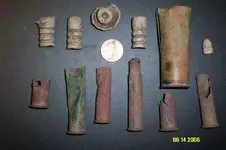Hi all,
I've been detecting for 2 weeks or so and found this forum. Great site and you guys have found some awesome items.
Here is a pic of some of the things i've found so far on property owned by my family for over a century in Illinois. The brass shotgun shell says "Winchester No. 10"...it was found on an old homesite that has been gone for over 75 years...any idea on age? Supposedly, on one area of our property, there was a military range and I found the shell casings and the lead bullets there. Were the bullets muzzeloader? Any information as to possible age, etc would be greatly appreciated. One of the shell casings says "F" "89" and "12". Thanks for your help, very interesting forum.
I've been detecting for 2 weeks or so and found this forum. Great site and you guys have found some awesome items.
Here is a pic of some of the things i've found so far on property owned by my family for over a century in Illinois. The brass shotgun shell says "Winchester No. 10"...it was found on an old homesite that has been gone for over 75 years...any idea on age? Supposedly, on one area of our property, there was a military range and I found the shell casings and the lead bullets there. Were the bullets muzzeloader? Any information as to possible age, etc would be greatly appreciated. One of the shell casings says "F" "89" and "12". Thanks for your help, very interesting forum.







 ?
?